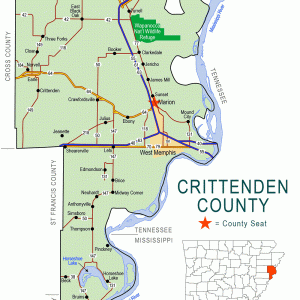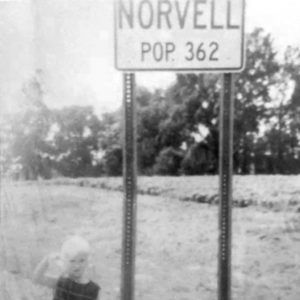calsfoundation@cals.org
Norvell (Crittenden County)
Norvell was an incorporated town in western Crittenden County located just southeast of the Tyronza River, about one mile east of the Cross County line. In 1862, Dr. James Throgmorton arrived in what would become Norvell. In later years, he described the landscape as “a dense forest inhabited by bears, wolves and panthers,” adding that “it remained so until 1888.” The raw wilderness with abundant virgin timber invited settlement and commercial growth during the timber boom that swept Arkansas following the Civil War. This growth gave rise to Norvell and its larger neighbor Earle (Crittenden County), which were settled simultaneously and shared many of the same business and civic leaders.
Population in the area was sparse until the 1880s, when the eyes of timber interests turned to eastern Arkansas, and the St. Louis, Iron Mountain and Southern railroad built its line just south of Earle in 1888. During this time, a community began to form that went by the names of Brown (named for Tom Brown, an early settler) and New Earle before finally bearing the name of Dr. Ben Norvell Sr., a prominent town leader. Norvell was formally incorporated in 1904; neighboring Earle was incorporated in 1905 and remained the largest town in Crittenden County until it was surpassed by West Memphis (Crittenden County) in 1940. Norvell had a peak population of 522 in 1920, but its population growth was always overshadowed by Earle. Norvell lacked its own access to the railroad, and in an age in which railroads determined the direction and flow of commerce, the town’s best hope was to share in Earle’s prosperity.
Postal service was first available in 1890. At that time, the Earle post office was actually located in Norvell at a general store owned by brothers John and Jacob Watt. An effort to have the post office moved resulted in the most scandalous event recorded in Norvell history, though some details are sketchy. W. M. “Grat” Brown, who owned property in Earle, wanted the post office moved, presumably to his own property or business. The controversy apparently escalated until Brown was fatally shot by John Watt on July 21, 1904. Watt claimed he shot Brown in self-defense and was acquitted at his trial, even though Brown’s gun was never located. Many years later, Ben NorvellIIIfound a fully loaded and cocked pistol inside a boxelder maple stump near the site of the shooting. Allegedly, this was Grat Brown’s pistol, which was hidden there by a lady friend of Brown after he was killed.
Timber harvesting was the primary business concern during Norvell’s heyday. At that time, the Tyronza River was navigable and was utilized by log rafts traveling to and from Norvell’s lumber mills. The largest lumber operation at work near Norvell was the Tyronza Lumber Company, which had land holdings around Norvell and operated a sawmill between Norvell and Earle that had a workday lumber capacity of 40,000 board feet. Other nearby lumber interests included the W. G. English sawmill to the southwest and the Lasater & Bailor slack-barrel stave mill, just north of town along the Tyronza River. The Tyronza Lumber Company closed its mill in 1913; other lumber firms in Norvell and Earle closed or moved as their supplies were exhausted. The last sawmill in the area ceased operations in 1957.
Besides the lumber companies, Norvell also had a handful of stores, saloons, a small mattress factory, and a two-story hotel. Due to the terrain and perennial problems with flooding, an elevated boardwalk was built along Norvell’s business district and extended across a marsh into Earle, providing the only passable connection between the towns during inclement weather.
Over time, Earle and Norvell grew until the boundary between the two was indistinguishable. It was probably inevitable that the question of consolidation would arise since both towns were founded by the same leaders and eventually came to share the same schools, utilities, and public services. A merger into one city of Earle was first proposed in 1913 and was considered every few years until Norvell was formally annexed after a 1978 referendum, despite objections from most of its citizens.
For additional information:
Woolfolk, Margaret Elizabeth. A History ofCrittenden County,Arkansas. Greenville, SC: Southern Historical Press, 1993.
Adam Miller
Searcy, Arkansas
 Crittenden County Map
Crittenden County Map  Gloria Norvell
Gloria Norvell 



Wow, we have a pic of my Aunt Gloria Norvell standing under the Norvell city limits sign. Ben Norvell was my mom’s (Patricia Norvell’s) grandfather and my great-grandfather. I absolutely love this history being accessible. I’d never heard about the post office/gun in a tree, so fascinating. My grandfather was James Chamberlain Norvell.